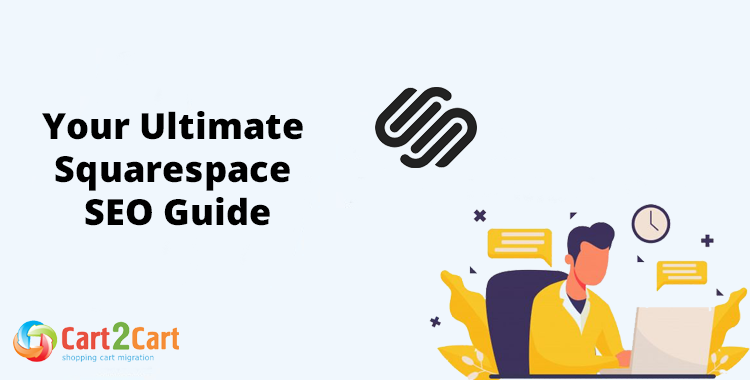Website traction is not about a beautifully designed website with stunning images; it's about whether the site is optimized for SEO. Achieving strong e-commerce traction will rank high on search engines and be seen by internet users searching for your Squarespace store.
In this Squarespace SEO guide, we'll give you some tried and tested tips to ensure that your site gets noticed by search engines, so your customers can find you.
Is Squarespace good for SEO?
Squarespace comes with built-in SEO tools, so website owners don't need to worry about the technical aspects of SEO. Understanding how to use these tools to optimize your site is crucial to your online success.
The problem is, it's not as simple as that. SEO is complicated and difficult to get right. Even with Squarespace's SEO abilities, you have to know what you're doing to get good results, and it's worth reviewing post-migration tips to ensure your efforts pay off.
The Squarespace sales pitch is that it comes optimized for SEO, but the reality is website owners can't just leave SEO up to Squarespace. That is why we offer you this Squarespace SEO tutorial.
Look through a short video guide with tips on how to set up your new store right after you’ve transferred the data from your previous store into it:
How to do good Squarespace SEO?
In this Squarespace SEO tutorial for beginners, we will discuss tips to improve SEO fro Squarespace.
1. Turn on SSL
Google gives preference to sites that are secure. Squarespace offers a free SSL certificate; turn it on.
2. Do keyword research
Keywords are the basis of SEO for Squarespace. The core of Squarespace SEO is keyword research. Keyword research will help you find the best keywords to target, giving you insight into the terms your target audience use to find you and businesses like yours.
A good keyword research tool is invaluable for this purpose.
3. Use a custom domain name
One way to do this is to use keywords in your domain name, which will give an indication of what your site is about. Choose a keyword targeted to your audience to include in your domain name. It should be relevant to your business. Choose a top-level domain extension like .com, .org, or .net. and keep your domain name short and easy to remember. Switching your domain name post-migration can be a smooth process with the right guidance.
4. Customize your URLs
Customize your URLs by using keywords in them. Your URLs should make sense, especially for product and service pages. The URL should be descriptive, short, indicative of the content, and easy to understand.
Tip: URLs should be based on user needs rather than the name of a product or service.
Short and clean URLs do well on search engines and users also trust them more.
Note: look through the Cart2Cart Blog for useful tips & tricks on how to migrate data across various shopping cart solutions.
5. Organize your content with tags and/or categories
Google likes to navigate through organized content. Make life easy for Google with tags and/or categories. Also, add image tags to help Google.
6. Post high-quality content
Write and post superior content that is well-written, of a certain length, and offers useful information that adds value. Consider how migration customization services can help ensure your unique content translates perfectly.
7. Optimize content length
Generally, long-form content over 1,500 words tends to rank well.
8. Use good formatting principles
Your writing should have a heading and several subheadings. Use short paragraphs to make the work more readable. Break the writing up with bullet points, and use italics and bold to highlight content.
9. Invite blog comments
Comments on your blogs are a great way to engage with your audience and find out more about them. You can use the information to better target your audience.
10. Respond to comments
Responding to comments from your site visitors is a way to give your business a human face and people actually engage with people, not entities.
11. Optimize your blog images.
Use high-definition images that you compress so they don't slow down your page loading time.
12. Use internal links
Use internal links that link to other content on your site. Google is responsive to internal links.
13. Build backlinks
Building backlinks is great for Squarespace SEO. You get the most out of backlinks if you use them to link to good content on sites relevant to your website content. Search engines promote pages that feature many backlinks.
14. Use related posts plugins
You can also links that refer to related posts. There are plugins that do that for you automatically. This trick is great for sales and for SEO for Squarespace.
15. Use external links
This is another practice that is favored by Google. Link to other websites whenever applicable.
16. Post regularly
The intervals between publishing content are not as important as posting regularly. The point is to produce high-quality content regularly.
17. Optimize your meta description
Meta descriptions are those short blurbs displayed on the Search Engine Results Page. Users read it to see what the page is about. It's often the thing that makes users decide to click on a page, so pay attention to your meta descriptions.
12 on-page SEO tips for Squarespace
1. Begin with keyword research to guide the creation of high-quality content
Conducting keyword research is a crucial step in optimizing your Squarespace website (or any website) for SEO. For each page on your site that will be indexed by search engines, you should identify a primary or "focus" keyword (or keyphrase) that you want to rank for.
If you already have a lot of content and haven't done any keyword research yet, don't worry. Start with your highest priority pages—those that have the most direct impact on your business goals.
Create a spreadsheet to list every page on your website, including columns for:
- URL
- Focus keyword
- Page title
- Meta description
These columns will get you started, and you'll use them in the next steps to improve your SEO strategy.
2. Optimize your title tags
FAQs
Can Squarespace sites rank on Google?
Yes, Squarespace websites can indeed rank on Google and other search engines. Squarespace provides a solid foundation for implementing good SEO practices, and many Squarespace websites have achieved high search engine rankings. However, like any website, the success of ranking on Google depends on various factors and the effort you put into optimizing your site.
Here are some factors to consider when aiming to rank your Squarespace site on Google:
- Content Quality and Relevance
- On-Page Optimization
- Site Structure and Navigation
- Mobile Responsiveness
- Image Optimization
- Page Speed Optimization
- External Links and Backlinks
- Structured Data Markup
- XML Sitemap Submission
- Monitor Analytics
- Consistency and Patience
SEO takes time to yield results. Consistently apply best practices and monitor your progress over time.
What's the best template for Squarespace SEO?
Squarespace has several templates that are excellent for SEO. One of them is the Bergen Template. The good news is you don't have to pay for it. It’s a free template from the latest version of Squarespace.
If you use Bergen, search engines can easily find your website. The template allows access to the whole range of Squarespace SEO tools.
This template doesn't have too many elements – it is ready for you to tailor to your needs. In addition, the loading speed is above average and that applies across all devices.
Is WordPress better for SEO than Squarespace?
Both platforms have SEO capabilities out of the box. Squarespace has a lot of SEO features, including custom URLs, responsive content, generating an XML sitemap, URL redirections, and more.
WordPress also has great SEO features out of the box, but the platform also has a phletora of SEO apps for users to optimize their sites for SEO. However, to get the best out of WordPress in terms of SEO, you really need to be able to code.
So, while WordPress has more to offer, most people will get more out of Squarespace because it's simpler to work with.
Does Squarespace have an SEO plugin?
No, Squarespace doesn't have an SEO plugin. That is because Squarespace comes with SEO built in.
Can you get good SEO with Squarespace?
Yes, Squarespace does offer good SEO (Search Engine Optimization) capabilities, and you can achieve effective search engine visibility with proper optimization practices. While Squarespace might not be as customizable as some other platforms, it provides several built-in tools and features that can help improve your website's SEO performance. Read the article to find more detailed information about the best tips & tricks to achieve good SEO with Squarespace.
While Squarespace provides tools to optimize your website for SEO, it's important to remember that SEO is an ongoing effort. Regularly monitoring your site's performance, keeping up with SEO best practices, and adapting to changes in search engine algorithms are essential for maintaining good SEO rankings.
Is Squarespace 7.1 better for SEO?
Squarespace regularly introduces improvements that can positively impact SEO, but it's important to note that various Squarespace versions offer solid SEO capabilities. Squarespace continually works to enhance its platform's SEO features, and while Squarespace 7.1 includes certain updates, the choice between versions may depend on your overall website design and functionality needs.
Ultimately, both Squarespace versions can offer good SEO capabilities. Choose the version that best aligns with your website's design, functionality, and customization needs while keeping SEO best practices in mind. Regularly updating your content, optimizing metadata, and following SEO guidelines are crucial regardless of the version you choose.
Is Wix better than Squarespace SEO?
Both Wix and Squarespace offer SEO features that can help improve your website's search engine visibility, but the effectiveness of SEO depends on various factors, including your website's content, structure, and optimization efforts.
Ultimately, both Wix and Squarespace can provide effective SEO capabilities, but your choice should be based on a holistic assessment of your website's needs and your comfort with the platform. Consistently implementing SEO best practices, producing high-quality content, and engaging in link-building efforts are essential regardless of the platform you choose.
Leave a Reply Cancel reply
We’d love to hear from you about your experiences with implementing Squarespace SEO strategies to enhance your website's visibility! Have you found success with optimizing your Squarespace site for search engines? Share your thoughts, questions, and insights in the comments below. Whether you've encountered challenges or discovered effective techniques, your feedback can help others navigate the complexities of Squarespace SEO and improve their website's online presence. Join the conversation and contribute to the collective knowledge of Squarespace SEO optimization!
One thought on "Ultimate Squarespace SEO Guide: Boost Your Website's Visibility"
Implementing Squarespace SEO strategies is vital for any website looking to boost its visibility and attract organic traffic. This comprehensive guide provides invaluable insights and actionable tips to optimize Squarespace sites effectively. From keyword research to technical optimization and content creation, it covers all aspects necessary to improve search engine rankings and drive more visitors to your website. Following these best practices can lead to significant improvements in search engine visibility and ultimately help businesses achieve their online goals.
We hope you find this basic Squarespace SEO tutorial useful.
What can we do for you?
Are you planning to migrate your store? If you are thinking to migrate from your existing store to another one, like from Squarespace to WooCommerce, the Cart2Cart Shopping Cart Migration tool can accomplish it for you with no fuss. Ours is an advanced automated migration tool that transfers all your data to another platform quickly, and securely.
Monthly Update – December 2025
As we approach the end of 2025, the landscape of Squarespace SEO continues to be shaped by advancements in AI and evolving search engine algorithms. A key trend for Squarespace store owners is the heightened emphasis on E-E-A-T (Experience, Expertise, Authoritativeness, and Trustworthiness). Google's continuous refinement of its ranking factors means demonstrating genuine experience and authority in your niche is paramount. For Squarespace sites, this translates to consistently publishing original, insightful content, showcasing customer testimonials, and clearly articulating your brand's unique value proposition.
Furthermore, local SEO optimization remains crucial for businesses with a physical presence. Ensure your Squarespace site’s business information is meticulously updated across all online directories, including Google Business Profile. Utilize location-specific keywords within your content and meta descriptions to attract nearby customers. The integration of generative AI in search results also means concise, direct answers to user queries are increasingly favored. Structure your content with clear headings and FAQs to optimize for these new AI-driven answer formats.
For more details, explore our FAQ section or schedule a call with a migration expert.










Comment by gate io review
Reading your article helped me a lot and I agree with you.